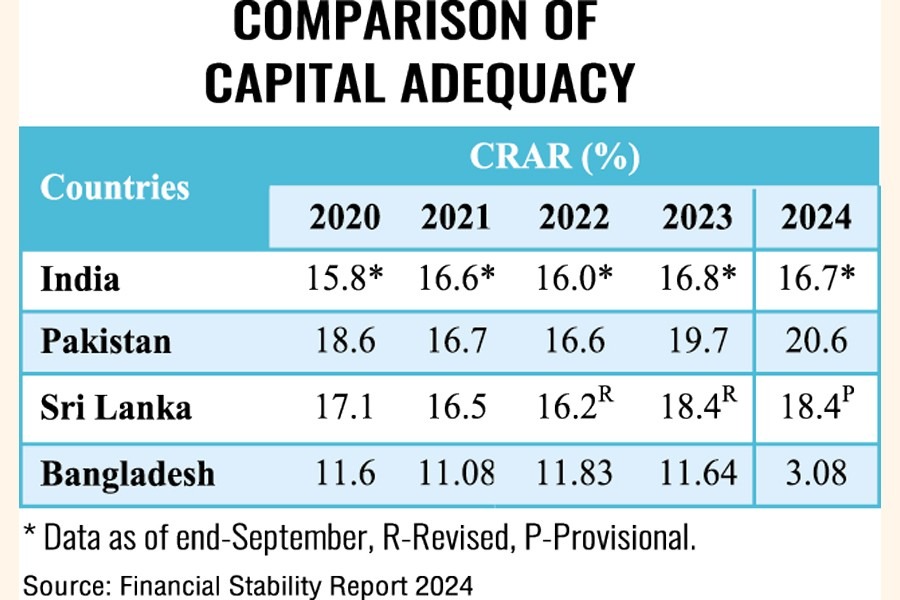Higher NPLs reduce banks' capital adequacy to lowest in South Asia
Non-performing loans hit Tk 3.45t by end of 2024

Published :
Updated :

Higher classified loans have dragged the capital adequacy of Bangladesh's banking sector to the lowest level among neighbouring South Asian countries, officials said.
The capital-to-risk-weighted-asset ratio (CRAR) fell drastically to 3.08 percent in 2024, driven largely by weak capital positions in state-owned commercial banks (SoCBs), specialized development banks (SDBs), and Islamic private commercial banks (PCBs), according to the Financial Stability Report (FSR) 2024 released Monday by the Bangladesh Bank (BB).
"The banking sector faced heightened stress in 2024, particularly regarding capital adequacy," the central bank said in its latest FSR.
The banking industry's CRAR decreased by 8.56-percentage points to 3.08 percent at the end of December 2024 from 11.64 per cent a year ago, the BB data showed.
The central bank in its latest FSR says the significant deterioration of capital adequacy in SOCBs, Islamic PCBs, and SDBs highlights the need for intensified supervision and targeted measures to enhance their capital positions, thereby strengthening both their individual resilience and the overall stability of the banking sector.
"Higher non-performing loans (NPLs) have pushed down the CRAR of Bangladesh's banking system to the lowest level among neighbouring countries as of end-December 2024," Mohammad Shahriar Siddiqui, acting spokesperson for the central bank, told The Financial Express (FE) in response to a query.
Classified loans in Bangladesh's banking sector continued to rise sharply, with the cumulative volume surging by more than Tk 2.0 trillion year on year as of last December.
With such a surge in NPLs, the volume hit a record Tk 3.45 trillion by the end of last year, accounting for 20.20 per cent of the total Tk 17.11 trillion in loans disbursed by all scheduled banks in the country. The banks had kept aside more money from their capital for maintaining provisioning requirement against their NPLs, said Mr. Siddiqui, also a director of the BB.
"We've already asked all the scheduled banks to expedite their loan-recovery drives for improving financial health," the central banker notes.
In SAARC countries, Pakistan maintained the highest level of CRAR at 20.6 per cent in 2024, followed by Sri Lanka, India, and Bangladesh at 18.4 per cent, 16.7 per cent, and 3.08 per cent respectively, according to the FSR.
The CRAR figure for Indian scheduled commercial banks was compiled as of end-September 2024, instead of December, according to another central bank official.
Bangladesh started implementing Basel-III for calculation of CRAR of all the scheduled banks from the first quarter of 2015 for consolidating the stability in the banking sector.
Currently, banks are required to maintain a capital conservation buffer (CCB) of 2.50 per cent of total risk-weighted assets in the form of common equity tier-1 (CET-1) capital in addition to the minimum regulatory capital requirement (CRAR) of 10.0 per cent under the Basel-III framework.
Basel-III is a new global regulatory standard on banks' capital adequacy and liquidity as agreed by the members of the Basel Committee on Banking Supervision. The third of the Basel Accords was developed in response to the deficiencies in regulation exposed by the global financial crisis of 2008. Basel-III is set to strengthen the bank capital needs and introduce new regulatory requirements for bank liquidity.
siddique.islam@gmail.com


 For all latest news, follow The Financial Express Google News channel.
For all latest news, follow The Financial Express Google News channel.